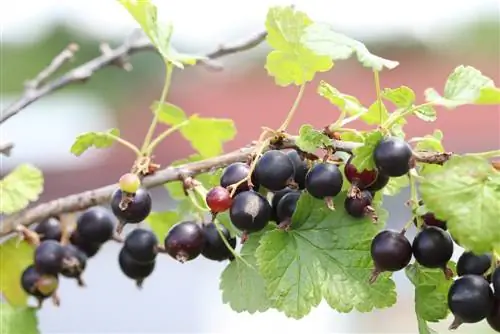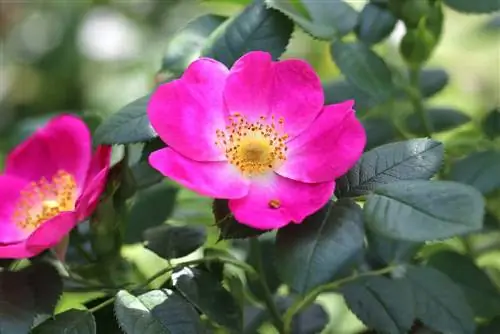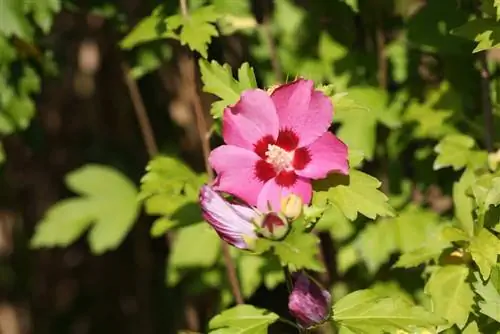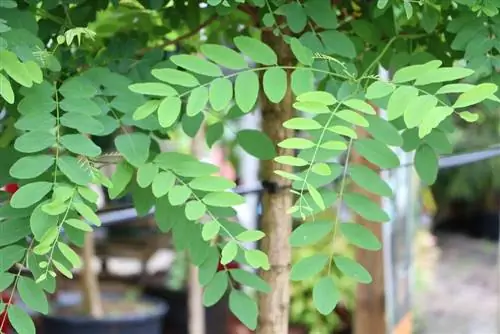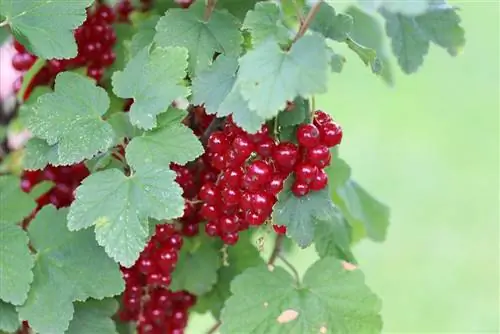- Author admin [email protected].
- Public 2023-12-17 03:39.
- Last modified 2025-01-24 12:45.
The blackcurrant, which belongs to the gooseberry family, is a real vitamin C bomb and is therefore very he althy, especially when eaten raw directly from the bush into the mouth. In addition to red and white currants, black currants are also very popular in local gardens. The fruits can be used in jellies, as juice, as jam and even as fruit wine. There is also a wide variety of varieties, which differ primarily in the harvest time. A distinction is made here between early, mid-early and late berries.
Varieties
There are different varieties of blackcurrants, which differ primarily in the harvest time. There are early, mid-early and late varieties, all of which ripen at different times. However, all Ribes nigrum varieties offer a special and delicious taste and usually a large yield.
“Silvergieter’s Black”
The black currant “Silvergieters Schwarze” is a popular, early variety. The upright growing shrub reaches a height of up to 1.70 meters and a width of up to 1.30 meters. It also has the following properties:
- early fruit ripening
- Harvest between July and August
- sweet and sour taste
- very high crop yields
- undemanding
- tends to leaf diseases
- Flowering time in April
“Ben Sarek”
The black currant “Ben Sarek” is an early to mid-early fruit that is also well suited for container planting, as it is not quite that big at one meter high and 80 cm wide. The berry also has the following properties:
- sour taste
- high crop yields
- very robust against mildew
- blooms between April and May
- Harvest time between July and September
- also offered as a standard tree
“Hedda”
Ribes nigrum “Hedda” is a medium early, very tall growing shrub, this blackcurrant can grow up to 2 meters high. The fruits it bears are also quite large, with an aromatic, sweet and sour taste. Further properties are as follows:
- blooms between April and May
- Harvest time between July and August
- very high crop yield
- very robust and easy to care for
“Andega”
The black currant “Andega develops tasty, tart and, above all, pitch-black and plump fruits in summer. It is one of the early varieties of berries. Above all, the other properties of this variety should be mentioned as follows:
- Blossom in April
- Fruits as early as June to August
- very rich in vitamins
- undemanding
- grows up to 1.50 meters high and wide
“Ben Alder”
The blackcurrant variety “Ben Alder” is one of the later of the tasty berries. It is very productive and is particularly suitable for making your own juice. Since the shrub only grows up to 1.50 meters wide and high, it is also suitable for keeping in a container on a balcony or terrace. The following can be said about this variety:
- Flowering in April to May
- Harvest end of July to August
- sweet and sour taste
- very rich in vitamin C
- very resistant variety
“Titania”
The medium-late variety “Titania” can also be cultivated as a standard tree. As a shrub it grows up to 1.50 meters high and 1.20 meters wide. It produces fruits that are very rich in vitamins and taste sweet and sour. The following should also be mentioned about this variety:
- Flowering between April and May
- Harvest between the end of July and August
- very large, black berries
- very resistant to all kinds of diseases
- also suitable for gardening beginners
Location
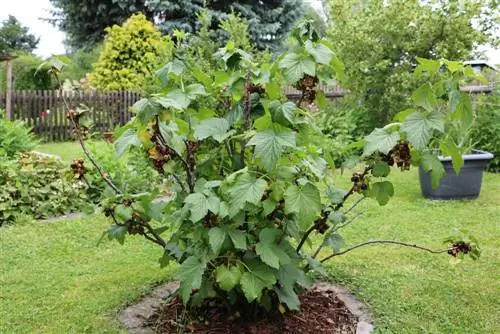
The ideal location for the blackcurrant in the garden looks diverse. The shrub can tolerate a little partial shade as well as full sun. She just shouldn't be offered constant shade. The selected locations can look like this:
- in a sunny garden bed
- on a sunny meadow
- can be planted together with other shrubs
- as a hedge to the neighboring property
- in a partially shaded or sunny corner of the house
- on a sunny balcony or terrace in a bucket
- Protect early varieties
- Flowers can die in night frost
Tip:
If you don't have a garden, you can also cultivate the blackcurrant as a small bush or standard tree in a pot and place it on the balcony or terrace.
Plants
The best time to plant blackcurrants is autumn, when there are no more fruits on the bush. The berries are available in well-stocked stores as bushes or already grown in pots as standard stems. Before the plant is planted, the soil should be prepared one or two weeks in advance. The procedure is as follows:
- Loose the soil well and fold in compost, sand and clay
- dig the planting hole after one to two weeks
- create a drainage system made of stones or pottery shards to prevent waterlogging
- Dig the hole so far that the pot ball completely disappears into it
- Remove the blackcurrant from the pot
- water the root ball well before planting
- insert and fill with soil
- Press lightly, water and then mulch
Tip:
The bushes should be cut for the first time immediately after planting so that a base of a few shoots is formed from which new shoots will sprout in the spring.
Cultivate in a bucket
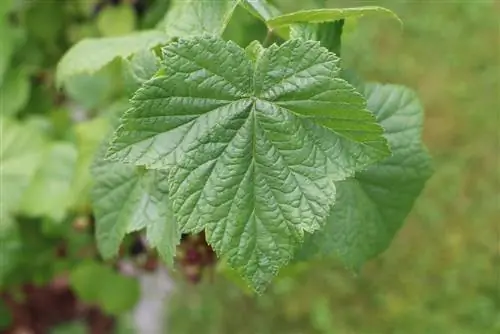
Since the currant bushes can be kept relatively small or cultivated as a standard tree, the black currant is also suitable for planting in containers on a balcony or terrace if there is no garden. A sufficiently large bucket is required for the implementation; since the berry has shallow roots, it needs enough space on all sides. Since waterlogging occurs more quickly in the pot, drainage must be created over the drainage hole made of potsherds or gravel. Ideally, plant fleece should be placed over this so that soil cannot block the drainage. A portion of the prepared soil is then filled in. Garden soil mixed with compost, sand and clay should be filled in, alternatively, if this is not available, normal potting soil for mixed cultures from the market. Then proceed as follows:
- remove small plant from pot
- Water the root ball well and insert it
- fill remaining soil
- press lightly and pour
- place in a sunny place
- In winter the bucket must be protected from frost
- cover with plant fleece or brushwood mats
- Add mulch to the soil
- Place the pot on Styrofoam or a thick wooden board
Since the nutrients are lost more quickly in the pot, the blackcurrant that was grown in a bucket must also be fertilized over the summer. For this purpose, special berry fertilizer is available commercially and is added to the irrigation water. The berry should be fertilized every two to three months.
Tip:
Even if the blackcurrant does not necessarily need to be repotted, it should still be provided with fresh soil about every two to three years.
Substrate & Soil
Currants, including the black ones, like it evenly moist. However, waterlogging should be avoided here, as the ground at the location should not be too wet. Otherwise, the shrub needs the following substrate to produce as many tasty berries as possible:
- nutrient-rich
- humos
- profound
- a mixture of garden soil, compost sand and clay is ideal
- Mulch sprinkled all around preserves moisture
Fertilize
Blackcurrants are usually fertilized twice a year, once in the spring before budding, the second time in the fall after the harvest. The ideal option here is to use compost, as it is a natural fertilizer that is always better for plants whose fruits are to be consumed. Mineral fertilizer can easily distort the taste, and it is not quite as he althy for the human body if it is consumed in larger quantities through the fruits. It is therefore sufficient if the bushes are fertilized with compost. This means you can avoid further fertilizer applications over the summer.
Pouring
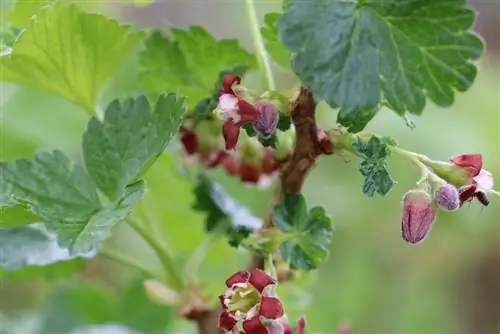
The blackcurrant is a shallow rooter, which means it needs regular watering, especially in a very hot and dry summer it needs to be watered daily. But waterlogging should also be avoided here at all costs. However, prolonged drought is also difficult to tolerate. Both hinder the yield and the growth of the tasty berries. It is therefore recommended to water as follows:
- if it is dry and hot, water every day
- ideal in the early morning or late evening hours
- water only at the roots, not over the bushes
- In spring and autumn there is enough rain
- Water potted plants even in the rain
- natural rainwater often does not reach the pot
Propagate
The black currant, like its red and white sisters, can be propagated by cuttings. If there is a particularly tasty variety in your own garden, you can easily grow additional bushes from it and the yield will be even greater. When propagating from cuttings, the ideal procedure is as follows:
- the ideal time is late autumn
- Choose a shrub with the highest and tastiest yield
- cut off he althy, annual shoots
- use a sharp knife for this
- cut the shoots into equal pieces
- about 20 to 30 cm long
- cut the bottom side diagonally
- can be placed in a growing bed with loose soil
- insert each cutting at a distance of 10 cm
- insert about 15 cm deep
Only two eyes on the cutting should be visible above the ground. Once all the cuttings are in the soil, it is lightly pressed all around and carefully watered. Mulch is then added over the entire growing bed. Next spring the first leaves will appear. Once the plants have grown large enough, they are transplanted to their final location. If you can wait longer, don't plant the young plants until autumn. The home-grown blackcurrant bushes produce their first harvest after about three years.
Tip:
If you don't have a growing bed available, you can also place the cuttings in individual small pots filled with growing soil.
Wintering
The black currant is absolutely hardy and requires no winter protection when cultivated outdoors.
Cutting
The blackcurrant must be cut regularly every autumn after the harvest, with the first cut taking place immediately after planting in autumn. But the black fruit definitely requires a different cut than is usual for the red and white varieties. Ribes nigrum bears fruit on the annual, long shoots that grow on the side. But the bushes can be kept in shape very well by cutting all around:
- remove all weak shoots from the base and main branches
- remove the oldest shoots directly at the base
- leave new shoots from the base
- The main branches are cut in spring
- to do this, cut over the second or third side shoot
Tip:
Always only use sharp and disinfected cutting tools for cutting. As a rule, a pair of rose scissors is sufficient, as the old branches of the blackcurrant are not particularly thick.
Cutting the high trunk
Some gardeners prefer the blackcurrant as a standard tree. These can be purchased already drawn in well-stocked stores. Berries cultivated in containers are often planted as standard trees because they do not require as much space as a bush. Unfortunately, this often comes at the expense of the productive harvest. Nevertheless, a standard tree is an eye-catcher even outdoors and should be cut as follows:
- remove all weak shoots
- all shoots that do not grow straight outwards in the crown
- Shorten the crown all around
- remove the oldest main shoots in the middle
- leave new shoots
Care errors
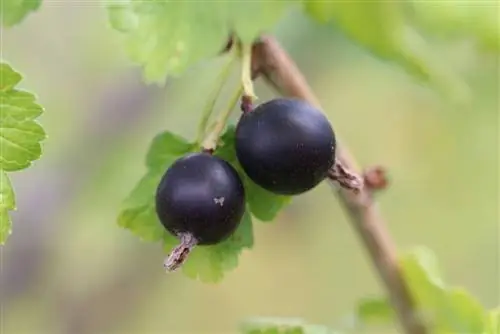
The flowers are lost due to trickling, this is also known with grape vines, it is not for nothing that a tasty wine is called “Riesling”. When the currant bushes are sprinkled, the flowers are shed. This happens if the shrub is too dry or has suffered a late frost during flowering. Temperatures that are constantly too low during the flowering period can also contribute to the flowers crumbling. This is of course very annoying because it damages the crop, but it is also completely natural, but it can be prevented. You should proceed as follows:
- plant several bushes close together
- Always keep the soil evenly moist
- several different varieties next to each other influence pollination
- Even if self-fertile, more flowers are pollinated
- If night frosts are to be expected, cover with plant fleece overnight
Tip:
When the large and tasty fruits of the blackcurrant appear in summer, they are always very popular with the local birds of all species that live around the garden. Therefore, in order to guarantee a rich harvest, it is helpful to stretch a net around the bush or the crown of a standard tree when the first fruits form.
Diseases
The black currant is susceptible to red pustule disease. This leads to the affected branches dying; orange-red dots then appear on the dead wood. If the berry bush is affected by this disease, only a strong pruning down to the base will help. Leaf drop disease is also very common in Ribes nigrum. This is a fungus that causes the leaves to drop prematurely. Fungicides can be used against this. These diseases are particularly common in very humid summers.
Tip:
And the location should also be checked in such a case. If the bushes are close to conifers, this can also be the cause, as these are carriers and hosts of various fungal diseases and thus also promote blackcurrant infestation.
Pests
The main pests are spider mites, scale insects, gall mites and aphids. If one or two infestations become visible, insecticides can be used to combat them. If you don't want to use chemicals, you can try to combat the annoying pests with a mixture of dishwashing liquid, water and vinegar or a homemade nettle decoction.
Conclusion
The black currant, with its many tasty varieties, is a robust berry that should not be missing from any garden. Not only are the fresh fruits delicious to enjoy, they can also be quickly and easily processed into many delicacies. If you want to enjoy the delicious berries all year round, from early summer to autumn, you can plant different varieties. Because there are early, mid-early and late shrubs here. If these are all cultivated together in one garden, a longer harvest can be expected. Otherwise, there is not much to consider when caring for the robust blackcurrant, as it is quite undemanding and does not require any protection in the open field in winter. Only a little time should be spent on pruning in autumn so that a rich harvest is guaranteed next year.

